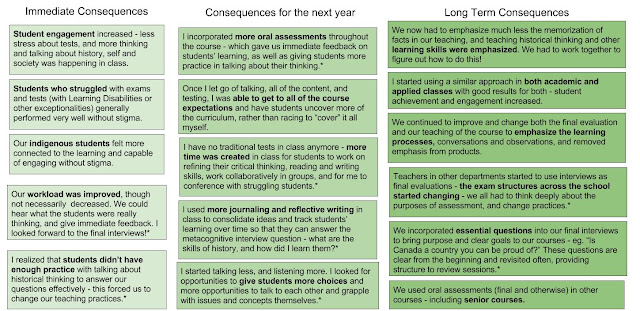Interview as Exam: Part 1 - Why do it?
This is the first post in a series on the Interview as Exam. This post outlines the causes and consequences for me and my students of doing this kind of assessment. The second explains the first kind of interview we started with in our history department. The third explains how and why we simplified the interview, and supported the learning all the way through the course. Part 4 is about assessing the interview.
"The primary purpose of assessment and evaluation is to improve student learning."
Growing Success, Ontario Ministry of Education, 2010.
In the past few months, I've had a few requests to share some of my experience (and resources) for doing interviews as final evaluations. After having written several lengthy emails, I thought it would be more efficient to write a blog post about the topic. I did write about my experience in the May 2012 issue of Rapport (OHASSTA's newsletter), but I have had so much more experience and thinking about this that I knew it was time for an update. This blog post will be about the WHY.
Being a good historical thinker, I thought it would be fun to look at the interview by creating a Cause and Consequence web and try to uncover why we started doing the interview and then look at the cascade of consequences that followed. I immediately realized that one web was not going to be enough - teaching is more complex than we realize!
Click here to see the full Causes document.
 |
| Causes of the Interview as Exam for grade 10 history (begun in 2012) |
Click here to see the full Consequences document.
The interview structure and format has changed over time, as I learned more about effective assessment and instruction practices. It's not a perfect solution to engaging all learners - but it does give me more time to listen to students so that I can spend more time on my fundamental task of evaluating "the effect of my teaching on students' learning and achievement." (Hattie, 2014).
In Part 2, I'll share what the interview looked like at the beginning, and how and why it changed.

This work is licensed under a Creative Commons Attribution 4.0 International License.

Comments
Post a Comment